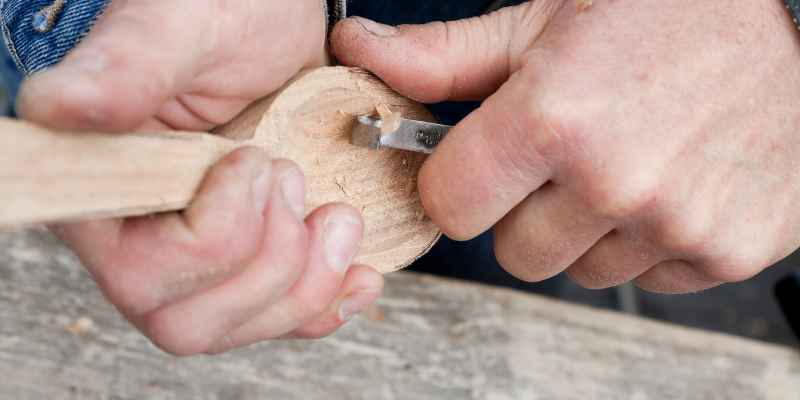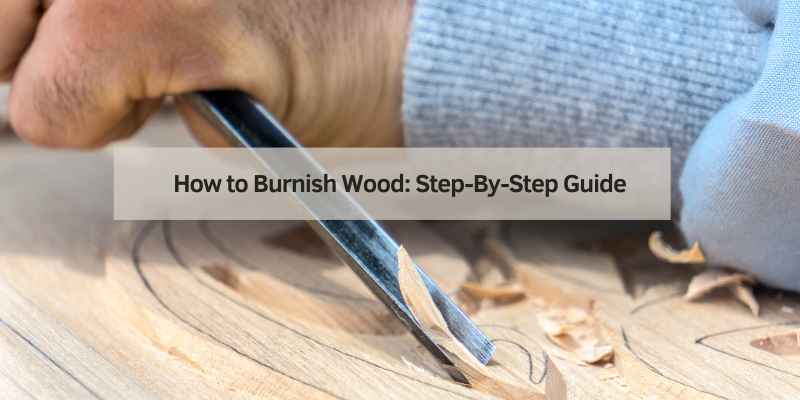To burnish wood, vigorously rub the workpiece with handplane shavings for a glass-smooth finish. Burnishing is a technique used by professionals to achieve a certain appearance and is commonly used for furniture, cabinets, floors, and other household items.
It is a quick alternative to chemical finishes that require drying time. Burnishing can also be done with brown paper or the backing of sandpaper, by rubbing the wood or coating surface to create a smooth texture. This method can be used on a sander as well.
Some people even use plastic or other materials for burnishing.
Benefits Of Burnishing Wood
Burnishing wood offers various advantages beyond traditional finishing methods. The process enhances the appearance, durability, and feel of the wood surface, making it a popular choice among woodworking enthusiasts.
Enhanced Smoothness
Burnishing wood results in a remarkably smooth surface, surpassing the texture achieved through conventional sanding techniques. This enhanced smoothness adds a touch of elegance to the woodwork, making it visually appealing and inviting to touch.
Improved Durability
Through burnishing, the wood fibers are compressed and strengthened, leading to improved durability. This process creates a protective layer on the surface, enhancing resistance to wear and tear, thus prolonging the lifespan of the woodwork.
Tools And Materials For Burnishing
To burnish wood, you need tools and materials like handplane shavings or burnishing oil. Professionals use burnishing to achieve a smooth finish on furniture, cabinets, and more. Rubbing the wood or coating with a brown paper or sandpaper backing can also create a smooth feel.
Types Of Burnishing Oils
Burnishing Brushes Vs. Sanding Pads
When it comes to burnishing wood, having the right tools and materials is essential for achieving a smooth and polished finish. Whether you are a woodworking enthusiast or a professional craftsman, understanding the different options available can greatly enhance your burnishing experience. In this section, we will discuss the types of burnishing oils and the advantages of using burnishing brushes over sanding pads.
Types Of Burnishing Oils
Choosing the right burnishing oil is crucial for achieving a beautiful and long-lasting finish on your woodwork. Here are some popular types of burnishing oils that you can consider:
- Lemon Oil: Known for its pleasant aroma and non-toxic properties, lemon oil is a popular choice for burnishing. It not only enhances the natural color and grain of the wood but also provides excellent protection against moisture and cracking.
- Tung Oil: Derived from the seeds of the tung tree, tung oil is a favorite among woodworkers for its deep penetration and durability. It creates a rich, warm, and glossy finish while offering superior resistance to water and scratches.
- Linseed Oil: Made from flaxseeds, linseed oil is a classic burnishing oil that provides a smooth and satin-like finish. It enhances the natural beauty of the wood and offers good protection against wear and tear.
Burnishing Brushes Vs. Sanding Pads
When it comes to removing imperfections and achieving a smooth surface, burnishing brushes and sanding pads are popular options. However, understanding their differences can help you make a more informed choice:
| Burnishing Brushes | Sanding Pads |
|---|---|
|
|
In conclusion, selecting the right burnishing oil and tools can greatly impact the outcome of your wood burnishing project. Whether you choose a specific type of burnishing oil or prefer burnishing brushes over sanding pads, it is important to consider the characteristics and requirements of your woodwork. By doing so, you can achieve a professional-looking finish that enhances the beauty of your wood pieces.
Step-by-step Guide To Burnishing Wood
Are you looking to add a beautiful sheen and a smooth finish to your woodwork? Burnishing wood is an excellent way to achieve a polished look, enhancing the natural beauty of the wood while offering protection and durability. In this step-by-step guide, we will walk you through the process of burnishing wood, from preparing the wood surface to handling blemishes. Let’s dive into the detailed steps of burnishing wood to bring out its natural beauty.
Preparation Of Wood Surface
Before you start the burnishing process, it’s essential to prepare the wood surface properly. Here’s a quick overview of the steps to prepare the wood surface:
- Begin by sanding the wood to a fine finish, ensuring that the surface is free from any rough patches.
- Clean the wood surface thoroughly to remove any dust or debris that may affect the burnishing process.
- Ensure that the wood is completely dry before proceeding to the next step.
Application Of Burnishing Oil
One of the key aspects of burnishing wood is the application of the right kind of oil. Follow these steps for the application of burnishing oil:
- Choose a high-quality burnishing oil that suits the type of wood you are working with.
- Apply the burnishing oil evenly across the wood surface using a clean cloth or brush.
- Allow the oil to penetrate the wood for the recommended duration as per the product instructions.
Techniques For Burnishing
When it comes to the actual burnishing process, you have a few techniques at your disposal to achieve the desired finish:
- Use a burnishing tool to rub the wood surface in a circular motion, exerting even pressure for a uniform finish.
- Alternatively, you can employ traditional methods such as rubbing the wood with the shavings of the same wood for a natural and effective burnishing technique.
Handling Blemishes
Despite the careful process of burnishing, blemishes may still occur. Here’s how you can handle blemishes effectively:
- Identify the blemished areas and sand them lightly to smooth out any imperfections.
- Reapply the burnishing oil to the affected areas, ensuring seamless integration with the rest of the wood surface.
Examples Of Burnishing Techniques
Burnishing Techniques involve various methods to enhance the appearance and texture of wood. Let’s explore some Examples of Burnishing Techniques below:
Burnishing Wooden Spoons
Burnishing wooden spoons is a meticulous process that involves enhancing the smoothness and sheen of the spoon’s surface without the use of sandpaper. This technique aims to create a polished finish that is both visually appealing and functional.
Burnishing Furniture Transfers
When burnishing furniture transfers, the goal is to eliminate any halo effect and ensure a seamless integration of the transfer onto the furniture surface. This technique requires precision and attention to detail to achieve a professional-looking result.
Burnishing Timber
Burnishing timber involves the act of rubbing the wood surface to enhance its smoothness and appearance. This simple yet effective technique can be done using materials like brown paper or the backing of sandpaper, resulting in a polished finish that elevates the timber’s natural beauty.
When To Burnish Wood
To achieve a smooth, glossy finish, burnishing wood is typically done after sanding and before applying the finish. It’s often used in furniture, cabinets, floors, and other household items to create a certain appearance without relying on chemical finishes. Burnishing can be done using handplane shavings, rubbing the wood vigorously for a glass-smooth finish.
Benefits of Quick Finishing
When it comes to wood finishing, time can be a crucial factor. That’s where burnishing comes in handy. Burnishing wood offers numerous benefits, especially when you’re looking for a quick finishing option. Let’s take a closer look at the advantages of quick finishing through burnishing.
- Time-saving: Burnishing wood is a time-saving technique that allows you to achieve a smooth and polished finish without waiting for chemical finishes to dry.
- Efficiency: With burnishing, you can quickly transform the appearance of your wooden furniture, cabinets, floors, and other items in the house.
- No need for sandpaper: Burnishing eliminates the need for sandpaper, making it a convenient and efficient method to achieve a polished look within a short period of time.
- Versatility: Burnishing can be used on various types of wood, making it suitable for a wide range of woodworking projects.
Achieving Specific Aesthetics
Besides its time-saving benefits, burnishing also allows you to achieve specific aesthetics on your woodwork. Whether you’re aiming for a rustic, vintage, or modern look, burnishing can help you achieve the desired result. Here are some ways burnishing can help you achieve specific aesthetics:
- Enhanced grain definition: Burnishing highlights the natural grain patterns of the wood, giving it a distinct and beautiful appearance.
- Smooth and polished finish: Burnishing creates a smooth and polished surface, adding a touch of elegance to your woodwork.
- Vintage charm: By selectively burnishing certain areas and edges of your woodwork, you can create a vintage, worn-out look that adds character and charm.
- Modern sophistication: Burnishing can also be used to achieve a sleek and modern look by creating a glossy, reflective surface on the wood.
Now that you know the benefits of quick finishing and achieving specific aesthetics through burnishing, you can confidently explore this technique to enhance the beauty of your woodwork.
Alternative Methods For Burnishing

Besides the conventional methods, there are alternative techniques to achieve a smooth and polished finish when burnishing wood. Let’s explore these innovative approaches that can elevate your woodworking projects.
Using Handplane Shavings
One unique method involves utilizing handplane shavings to impart a glass-smooth finish on your woodwork pieces. Simply take a handful of shavings and vigorously rub them on the workpiece to achieve a remarkable polished surface.
Boning And Burnishing
If you are seeking a traditional yet effective technique, boning and burnishing can work wonders on your wood projects. This method involves using a bone or wooden tool to rub the surface of the wood, enhancing its smoothness and sheen.
Frequently Asked Questions Of How To Burnish Wood
What Can I Use To Burnish Wood?
You can burnish wood by vigorously rubbing the surface with handplane shavings for a smooth finish. Burnishing is commonly used for furniture, cabinets, floors, and other wooden items. It is a technique used to achieve a certain appearance quickly and can be done when professionals don’t have time for chemical finishes to dry.
When Should You Burnish Wood?
Burnish wood to achieve a smooth finish quickly for furniture, cabinets, floors, and other wooden items.
How Do You Burnish Furniture?
To burnish furniture, rub the surface with brown paper or sandpaper backing to achieve a smooth finish.
How Do You Burnish Timber?
To burnish timber, rub the wood or coating using brown paper or the back of sandpaper for a smooth finish. You can also use a sander, just rub the surface to achieve the desired smoothness. Burnishing is commonly used for furniture, cabinets, and various wooden items.
Conclusion
Burnishing wood provides a unique and smooth finish that can enhance the appearance of furniture, cabinets, floors, and other wooden items in your home. By rubbing the wood with handplane shavings or using the appropriate tools like burnishing oil and brushes, you can achieve a glass-like surface.
Burnishing is a technique used by professionals to save time on drying chemical finishes and achieve a desired look. So, why not try burnishing to give your woodwork a polished and refined finish?


